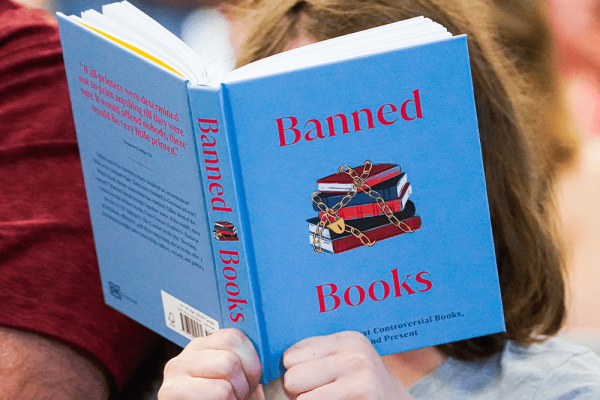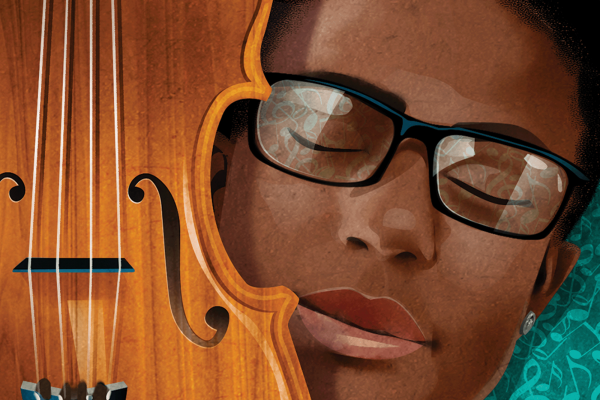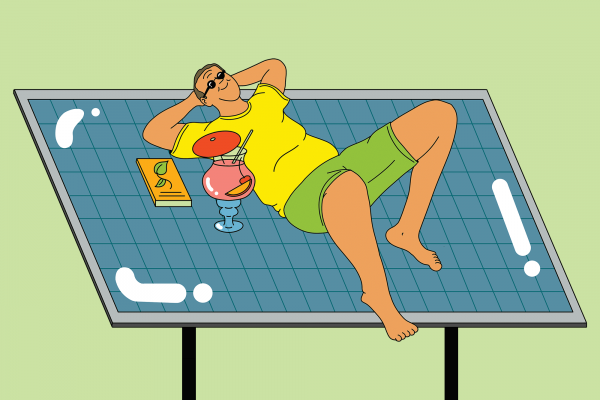Book-banning has always been about censoring the stories, histories, and information that push us to question the status quo. From the mid-18th century to the mid-19th century, states throughout the Southern U.S. enacted anti-literacy laws, restricting enslaved people’s ability to read and write. During the Holocaust, Nazis burned books they considered “un-German.” And today, school districts across the country are banning books that have LGBTQ+ and racial themes. Many of these bans claim to protect minors from material that is not age appropriate, but in reality, they restrict stories related to race, sexuality, and gender.
Book-banning across the country continues to rise with some districts firing librarians and teachers for using “banned” books. In March, the American Library Association reported the number of book challenges across the country nearly doubled from 2021 to 2022. Further, a record-breaking 2,571 individual books were earmarked for censorship, an increase of 38 percent from 2021.
In some districts, there’s even been moves to ban one of the most notable books of all time — a book that contains stories of incest, rape, and slavery: the Bible.
One parent in Colorado, among others in Utah and Texas, challenged the Bible’s place in school libraries because of its “explicit and inappropriate sexual and violent content,” including “incest and rape, promiscuity, gang rape, obscenity, infidelity, and abortion.” The parent, Rob Rogers, requested the Bible’s removal to make a point after a conservative group rallied to get several LGBTQ+ books banned from El Paso County, Colorado’s largest school district.
“This isn’t about the books,” he wrote in a letter to the school district. “It’s about the principle. It’s about ensuring fairness and equity. When books by brilliant authors are being removed based on subjective ‘standards,’ the rule should apply to all.”
Christians are called to tell the truth, even and especially when it’s uncomfortable. The truth about racism and chattel slavery is raw, graphic, and traumatic, but pretending that slavery never happened or that racism doesn’t exist won’t make those realities go away. Neither will ignoring the existence of LGBTQ+ people or the questions many young people face when thinking about gender and sexuality.
A report from The Washington Post found that those who have pushed for the banning of books about gender and sexuality believe they are protecting children from “obscene” material. “[B]ook challengers say they are fighting for children’s innocence, sanity and well-being — and, some believe, for their souls,” writes Post reporter Hannah Natanson. But Christians know that the truth, though sometimes uncomfortable, shall set us free (John 8:32). God has created us all uniquely, with different desires, life experiences, and talents. To understand the full breadth of humanity and God’s creation, both children and adults should have access to books that teach them the truth about the world and their neighbors.
Here are eight banned books we suggest adding to your faith and justice reading list:
1. Anne Frank’s Diary: The Graphic Adaptation, by Ari Folman, illustrated by David Polonsky (2018)
Excerpts of a diary kept by Anne Frank during the Nazi occupation of the Netherlands have been translated into more than 70 languages and adapted into several plays and films, including the 1955 play, The Diary of Anne Frank. However, Ari Folman, whose parents are survivors of the Holocaust, is the first person to adapt the diary into a graphic novel (graphic novels are one of the most common types of books being banned). Florida Rep. Randy Fine claims that Folman and Polonsky’s adaptation contains pornography, and Moms for Liberty stated that the adaptation “minimizes the Holocaust.” The graphic novel contains two passages from the diary regarding sexuality that were not included in many previous adaptations of Franks’s diary: In one passage, Frank expresses attraction to another girl, and in another, Frank discusses her genitalia — both examples of healthy explorations of sexuality for teenagers. Through its inclusion of illustrations and Frank’s thoughts on sexuality, this adaptation helps the reader get a visceral sense of what it is like to come of age while your world is falling apart. The Anne Frank Fonds, the foundation which holds the copyright of the diary, has approved the graphic novel.
2. Between the World and Me, by Ta-Nehisi Coates (2015)
Coates’ letter to his son was removed from schools in South Carolina after students in an AP class wrote to the school board saying the content made them uncomfortable. In May, South Carolina passed a bill that banned the teaching of controversial concepts regarding race and sex. Loosely inspired by James Baldwin’s letter to his nephew in The Fire Next Time, Coates’ letter to his son details his life as a Black man in the U.S.
Coates, an atheist, has a nuanced view on how religion influences the world. In Between the World and Me, Coates acknowledges the significance of the Black church in the fight for racial justice. Describing Civil Rights activists in the ’60s, he writes, “I think they are fastened to their god, a god whom I cannot know and in whom I do not believe. But, god or not, the armor is all over them, and it is real.” Coates may not be a Christian, but his work is certainly no less cosmological. Coates’ writing pushes readers to reflect on what they believe about violence, hope, and God’s will.
3. Hood Feminism: Notes from the Women That a Movement Forgot, by Mikki Kendall (2020)
In Hood Feminism, Mikki Kendall shows readers the intersections where mainstream white feminism has fallen short by concerning itself not with “basic survival for the many, but on increasing privilege for the few.” Kendall points to specific issues of justice that white feminism has largely ignored, including food insecurity, homelessness, education, safety, health care, and economic justice, as well as how race, gender, and sexuality intermix with these issues. Texas Rep. Matt Krause included the title on his 2021 list of more than 800 titles that said could cause “discomfort,” including many books that discuss race, gender, and sexuality. Kendall doesn’t focus on religion in Hood Feminism, but as Bernadette Raspante wrote in her book review for The Table, which advocates for women’s ordination in the Roman Catholic Church, “Kendall reminds her readers, as prophets do, that our liberation is wrapped up in the liberation of others.”
4. The Fire Next Time, by James Baldwin (1963)
In this compilation of essays that’s been banned in schools across the country, Baldwin writes about systemic racism, white ignorance, and the hypocrisies of both the church and the Nation of Islam. In the first essay, “My Dungeon Shook: Letter to My Nephew on the One Hundredth Anniversary of the Emancipation,” Baldwin tells his nephew that “freedom” is not yet here, reminding him how the country is still built around white understandings of the world. Baldwin encourages him to disturb that societal structure. Referring to their white neighbors, Baldwin writes, “We, with love, shall force our brothers to see themselves as they are, to cease fleeing from reality and begin to change it.”
The second essay, “Down at the Cross: Letter from a Region of My Mind,” details Baldwin’s adolescence in Harlem, as well as his personal struggles with faith and the failures of white Christianity. At the core of these essays is the idea that we must understand ourselves to understand others. Baldwin’s words still resonate with readers 60 years after its initial publication.
5. Gender Queer: A Memoir, by Maia Kobabe (2019)
This illustrated memoir of Kobabe’s journey with understanding gender and sexuality is the most banned book in the U.S. Kobabe is nonbinary, and the memoir explores Kobabe’s experience first coming out as bisexual, then later as nonbinary and asexual. The book is banned based on claims that it has sexually explicit images, which include, for instance, depictions of a gynecological visit. In an interview with NPR, Kobabe explained the importance of including these images: “[I]t’s hard to fully explain, I think, how a gender identity can impact every facet of life as an adult without touching at least a little bit on sexuality.”
For cisgender people who don’t typically wrestle with their gender identity, or even see their sexuality as part of their identity, it is important to learn how these seemingly routine tasks, like a gynecologist appointment, can be dysphoric. As Kobabe told the New York Times in 2022, “When you remove those books from the shelf or you challenge them publicly in a community, what you’re saying to any young person who identified with that narrative is, ‘We don’t want your story here.’”
6. Beloved, by Toni Morrison (1987)
Beloved has been on banned book lists since as early as 2006. It is a heart-wrenching novel about the formerly enslaved Sethe and her family. When Sethe realizes she is being pursued by slavecatchers, she fears for her children’s futures, and kills her oldest daughter, Beloved, so Beloved will not be taken back into enslavement. Its storyline contains brutal themes of racism, sexuality, infanticide, and bestiality.
As Emily Knox, author of Book Banning in 21st-Century America, told Time magazine in 2022, “What she tried to do is convey the trauma of the legacy of slavery to her readers. That is a violent legacy. Her books do not sugarcoat or use euphemisms. And that is actually what people have trouble with.” In Beloved, spirituality is a balm amid the tragedy. Morrison’s spirituality, and that of her characters, is rooted in a love that inspires her to fight against injustice. Morrison reminds us in Beloved that “Love is or it ain’t. Thin love ain’t love at all.”
7. The Hate U Give, by Angie Thomas (2017)
Angie Thomas is not concerned that her debut novel has been on banned book lists basically since its release in 2017. The Hate U Give tells the story of Starr Carter, a teenage girl who witnesses police shoot her close friend during a traffic stop. This book contains issues many of today’s teenagers are wrestling with: racism and police brutality, drugs and profanity, and a Black protagonist who feels obligated to code-switch between life at home and life at her predominantly white private school.
Thomas was inspired to write this story because of her personal experience reckoning with the murders of young Black men by police. A Christian herself, Thomas says she admires the boldness of Christ. “I write books that make people uncomfortable, but honestly, as a Christian, I feel like that’s what I’m called to do. I’m not called to be comfortable.”
8. I Know Why the Caged Bird Sings, by Maya Angelou (1969)
Maya Angelou is among the top banned authors in the U.S. In the first of her seven autobiographical works, Angelou recounts the early years of her life, up until age 17, as she learns to challenge racism and patriarchy. A young Angelou finds freedom in literacy, relating to and learning from characters in the countless stories she reads. Angelou’s personal story involves intense experiences of racism and sexual abuse, which is grounds for removal in some school districts. Through her writing, Angelou teaches us that, try as the world might, the voices of those who long for justice will not be silenced. As she writes in her poem “Still I Rise,” “You may kill me with your hatefulness, / But still, like air, I’ll rise.”
Got something to say about what you're reading? We value your feedback!







